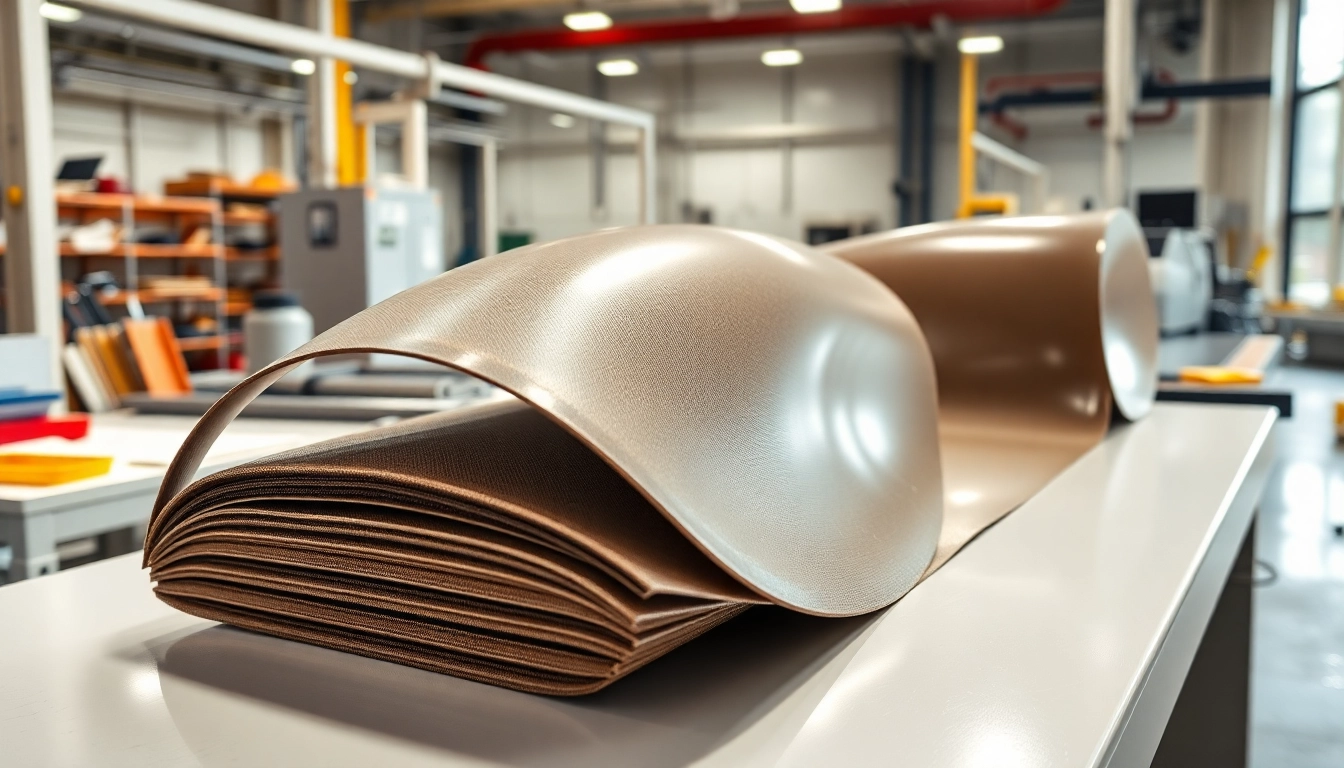Understanding Epoxy Prepregs
What Are Epoxy Prepregs?
Epoxy prepregs are sophisticated composite materials that play a critical role in advanced manufacturing processes across several industries. The term “prepreg” is short for “pre-impregnated,” indicating that the reinforcing fabric—typically carbon fiber or fiberglass—has been infused with a liquid epoxy resin. This unique configuration ensures that the resin is uniformly distributed throughout the fiber, offering exceptional performance characteristics when cured.
Unlike traditional composite materials, where the fibers and resin are combined at the time of molding, epoxy prepregs come ready-to-use. This not only simplifies the manufacturing process but also significantly enhances the control over resin-to-fiber ratios, resulting in improved strength, durability, and weight efficiency. Applications of epoxy prepregs span various fields, but their integration into sectors like aerospace, automotive, and sporting goods showcases their versatility and robust properties.
One should delve deeper into the unique composition and properties of epoxy prepregs to fully appreciate their significance. Epoxy prepregs boast unique physical and mechanical properties that are critical for high-performance applications.
Composition and Properties of Epoxy Prepregs
The primary components of epoxy prepregs include the reinforcement fibers and the epoxy resin matrix. The fiber reinforcement could be made from various materials, such as carbon fibers, glass fibers, or aramid fibers, each providing distinct mechanical advantages. The epoxy resin’s characteristics, which are responsible for binding the fibers, can also vary significantly depending on the formulation, influencing the overall properties of the composite.
Key properties of epoxy prepregs include:
- High Strength-to-Weight Ratio: This is particularly crucial in industries where weight savings directly contribute to performance, such as aerospace and automotive applications.
- Enhanced Durability: Epoxy prepregs exhibit excellent resistance to environmental factors, such as moisture, chemicals, and UV rays, ensuring longevity and reliability in harsh conditions.
- Low Shrinkage: The low shrinkage rate during the curing process translates to tighter tolerances and dimensional stability, essential for precision applications.
- Thermal Resistance: Many epoxy prepregs are engineered to withstand elevated temperatures, making them suitable for applications subjected to heat.
Understanding these properties allows manufacturers to tailor their applications according to specific performance requirements, which greatly enhances the design flexibility for advanced manufacturing projects.
Types of Epoxy Prepregs Available
Within the realm of epoxy prepregs, various types cater to different applications, primarily distinguished by their reinforcement materials, resin systems, and specific operational parameters. Below is an overview of the types available:
- Carbon Fiber Epoxy Prepregs: These are the most widely used prepregs due to their high strength and low weight. The high tensile strength and stiffness contribute to superb structural integrity, making them ideal for aerospace and high-performance sporting goods.
- Glass Fiber Epoxy Prepregs: While heavier than carbon fiber options, glass fiber prepregs still offer excellent tensile strength at a lower cost. Commonly used in automotive applications due to their superior impact resistance.
- Aramid Fiber Epoxy Prepregs: Known for their exceptional toughness and resistance to impact, aramid prepregs are utilized in applications requiring ballistic protection, such as military and security applications.
- Hybrid Epoxy Prepregs: These prepregs combine various fibers to enhance specific performance characteristics. The balance between weight, strength, and cost efficiency often leads to optimum designs.
The selection of an epoxy prepreg type depends on various factors, including end-use requirements, performance parameters, and budget constraints.
Applications of Epoxy Prepregs in Various Industries
Use in Aerospace Applications
The aerospace industry is one of the primary sectors benefiting from the advantages of epoxy prepregs. Their remarkable strength-to-weight ratio allows aircraft manufacturers to develop lighter and more fuel-efficient designs without sacrificing safety and performance.
Common applications in aerospace include:
- Structural Components: Parts such as wing spars, fuselage structures, and tails that demand high stiffness and minimal weight.
- Interior Fittings: Lightweight and aesthetically pleasing components created for passenger comfort and cabin design.
- Safety Equipment: Epoxy prepregs are used in manufacturing safety-critical components that require high performance under stringent regulations.
Epoxy prepregs facilitate the production of complex geometries through advanced manufacturing techniques such as autoclave curing and resin transfer molding, which lead to improved aerodynamics and overall aircraft performance.
Automotive and Transportation Advancements
In the automotive sector, the shift towards lightweight materials is propelled by the increasing demand for fuel efficiency and reduced emissions. Incorporating epoxy prepregs allows for manufacturing lighter components that enhance vehicle performance and efficiency.
Some notable applications in automotive include:
- Body Panels: Use of epoxy prepregs allows for the creation of lightweight yet durable body panels that withstand impact while improving fuel economy.
- Chassis Components: Critical parts such as suspension arms and structural reinforcements that require high-performance characteristics can be made from epoxy prepregs.
- Battery Enclosures: With the rise of electric vehicles (EVs), epoxy prepregs provide an optimal solution for creating lightweight, protective battery housings.
The automotive industry continues to innovate, and with the ongoing push toward sustainability, epoxy prepregs are likely to play an increasingly pivotal role in reshaping vehicle design.
Sporting Goods Industry Benefits
The sporting goods industry has embraced epoxy prepregs for their ability to produce high-performance equipment while offering exceptional strength and weight savings.
Applications in this domain include:
- Golf Clubs: The use of epoxy prepregs in shafts offers improved stiffness and swing speed, benefiting players seeking competitive advantages.
- Bicycles: High-end bicycles utilize epoxy prepreg frames that reduce weight and enhance performance without sacrificing durability.
- Snowboards and Skis: The manufacturing of these products leverages the lightweight and robust characteristics of epoxy prepregs, resulting in enhanced performance in extreme conditions.
The versatility of epoxy prepregs allows sporting goods manufacturers to innovate and create products tailored to the needs of athletes seeking optimal performance.
Manufacturing Process of Epoxy Prepregs
Step-by-Step Production Overview
The production of epoxy prepregs involves a series of carefully controlled steps designed to ensure high-quality outcomes. The typical manufacturing process includes the following stages:
- Preparation of Fibers: The fiber materials are cleaned and prepped for impregnation to ensure optimal adhesion.
- Resin Mixing: A specific epoxy formulation is created, including hardeners and additives to achieve desired performance.
- Impregnation: The cleaned fibers are covered with the resin, typically using a process called “wet-out.”
- Curing: The impregnated material undergoes partial curing, setting the resin to a tacky state, which allows it to adhere to other layers when stacked.
- Cutting and Packaging: Once cured, the prepregs are cut into specific sizes and packaged for transportation.
This method guarantees that the epoxy prepregs meet stringent performance criteria before reaching the manufacturing plants where they will ultimately be molded.
Quality Control Standards and Measurements
Quality assurance is pivotal in the production of epoxy prepregs, especially in industries where performance is critical. Rigorous quality control standards must be followed to ensure that the materials meet specifications and function as intended within their applications.
Key quality control measures involve:
- Fiber Content Testing: A critical aspect where the ratio of fiber to resin is measured to confirm it aligns with specified design parameters.
- Shear Strength Tests: Evaluate the bond strength of the resin and fibers to predict performance under load.
- Visual Inspections: Ensure that there are no defects in the fabric or the epoxy infusion, which could affect end-use performance.
Establishing these measurements ensures the reliability and safety of the constructed end products, especially in high-stakes applications.
Environmental Considerations in Manufacturing
Manufacturing epoxy prepregs, while beneficial from a performance perspective, presents several environmental challenges. Producers are increasingly tasked with minimizing their ecological footprint while maintaining high-quality outputs.
To address these concerns, companies are implementing sustainable practices, such as:
- Use of Eco-Friendly Resins: Development and use of bio-based epoxy resins that reduce reliance on petroleum-derived products.
- Waste Management Strategies: Processes for capturing and recycling off-cuts and defective products from prepreg production.
- Energy-Efficient Techniques: Adopting manufacturing technologies that reduce energy consumption during production.
By placing emphasis on sustainability, manufacturers of epoxy prepregs not only fulfill corporate social responsibilities but also meet the regulatory demands of an ever-evolving industry landscape.
Best Practices for Using Epoxy Prepregs
Storage and Handling Recommendations
The effective storage and handling of epoxy prepregs are crucial in maintaining their performance and extending the shelf life. The following best practices should be observed:
- Temperature Control: Store prepregs at low temperatures, often in freezers, to prolong shelf life and maintain resin viscosity.
- Avoid Moisture: Maintain a dry environment as moisture absorption can adversely affect the curing process.
- Proper Packaging: Keep prepregs sealed in airtight packaging to prevent exposure to environmental contaminants.
Adhering to these practices ensures manufacturers maximize the benefits of epoxy prepregs while minimizing risks associated with degradation.
Curing Techniques for Optimal Performance
Curing is a critical step in the prepreg process, transforming the uncured resin into a solid matrix that provides strength and rigidity. Different curing methods exist, and selecting the appropriate technique is vital for achieving the desired material properties.
Common curing methods include:
- Autoclave Curing: Utilizes high pressure and temperature in a controlled atmosphere, resulting in high-performance outputs.
- Oven Curing: Less complex than autoclaving, this method requires proper temperature calibration to achieve desired curing levels.
- Press Molding: Involves direct application of pressure to activate the resin curing process, delivering robust components.
A thorough understanding of each method will inform manufacturers about which process aligns best with their production requirements.
Preparing Epoxy Prepregs for Molding
The preparation of epoxy prepregs for molding is an intricate process that involves several key steps to ensure optimal results. Proper preparation will dictate the final quality and performance of the completed composite component.
Steps to consider include:
- Layering Techniques: Correctly stack layers of prepreg according to design specifications, helping to achieve the intended structural integrity.
- Alignment: Ensure fibers are aligned in the desired direction to maximize strength and stiffness in key stress areas.
- Application of Release Agents: Use appropriate release agents on molds to ensure easy removal of cured components without damage.
Implementing these practices ensures that end products are not only functional but also optimized for performance.
Future Trends for Epoxy Prepregs in Advanced Manufacturing
Emerging Technologies and Innovations
The landscape of epoxy prepregs is evolving, driven by advancements in materials science and technology. To stay competitive, manufacturers are adopting novel approaches such as:
- Hybrid Materials: Integrating different fiber types or nano-materials to leverage the strengths of each for tailored properties.
- 3D Printing with Composite Materials: Utilizing epoxy prepregs in additive manufacturing processes to enhance design capabilities and material efficiency.
- Smart Materials: Research is underway to develop epoxy prepregs equipped with sensors that can provide real-time structural health monitoring.
Such innovations will undoubtedly redefine the applications and capabilities of epoxy prepregs, further enhancing their role in advanced manufacturing.
Market Trends and Industry Growth
The demand for epoxy prepregs continues to swell, spurred by the need for lightweight, high-strength materials across numerous sectors. Market trends indicate growth trajectories that highlight:
- Increased Adoption in Aerospace and Defense: As manufacturers seek to incorporate more advanced materials to improve performance, the market for epoxy prepregs in aerospace will expand steadily.
- Emergence in Electric Vehicles: The push for lighter, more efficient vehicles is propelling the use of epoxy prepregs in automotive contexts, particularly with the rise of EVs.
- Sustainable Practices Driving Demand: Environmentally friendly innovations and renewable materials are likely to see a surge as manufacturers adapt to sustainability challenges.
Overall, manufacturers who harness these trends are well-positioned to usher in new levels of performance and innovation within their supply chains.
Research and Development Directions
Innovation in epoxy prepregs will largely hinge on ongoing research and development efforts focusing on improving material characteristics while also addressing environmental concerns. The future directions include:
- Development of Bio-based Epoxy Resins: Continuous research is underway to create resins derived from renewable resources, which would reduce the carbon footprint associated with traditional epoxies.
- Enhancing Curing Processes: Investigating faster or lower-temperature curing processes, thereby simplifying the production while ensuring high-performance characteristics.
- Durability Improvements: Ongoing analysis aimed at increasing the lifespan and effectiveness of epoxy prepregs in challenging environments.
These directions will not just enhance the appeal of epoxy prepregs but also promote polished and efficient manufacturing processes in the years to come.








